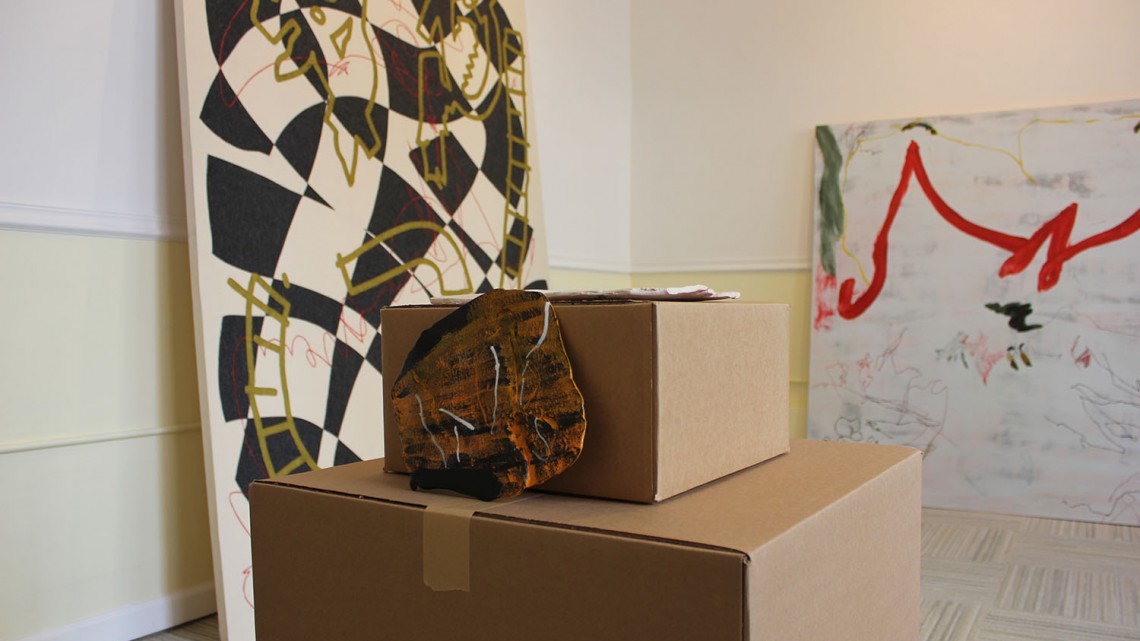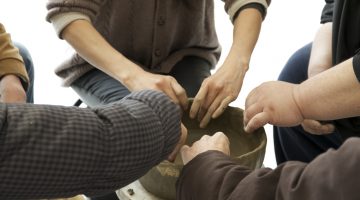I sat down with James Gobel and Maysha Mohamedi at the Lone Palm to discuss their show Gift A Feast at a pop-up space in SOMA.
Both Gobel and Mohamedi came to art-making in college. Gobel took undergraduate classes at the University of Nevada – Las Vegas to avoid having to move out of his parents’ house. It was there he began to take classes in the art department, led at the time by Dave Hickey. His education with Hickey and the eclectic visiting artist program, made of up of artists like Jim Shaw, Jeffrey Vallance, and Karen Carson, influenced Gobel’s conceptual approach to portraiture and his painting practice. Gobel has recently taken on the role Chair of Graduate Studies at the California College of the Arts in San Francisco.
Mohamedi began her academic career as a scientist, studying cognitive science. She began a PhD program in neuroscience, but quickly realizing her disinterest in that career path, began taking figure drawing classes on the side. While doing lab research in Tokyo, her sense of isolation as a foreigner fueled her desire to develop an artistic practice that would eventually lead her to the MFA program at the California College of the Arts.
***
Sarah Thibault: How did you first meet? (I know the answer)
James Gobel: Maysha should tell this story.
Maysha Mohamedi: CCA’s Dialogue & Practices (D&P) class, which is the intro grad seminar. I was not in James’ section, but I remembered your lecture that you gave and I really liked the lecture. The format of D&P is that every Friday two students got critiqued. And that was my first critique ever. I come from a different career so I was feeling pretty vulnerable. I made a ton of work that week and James was our guest critic. We go into my studio and it’s silent. James is walking around looking at everything I made and I was really scared and he’s going ‘Hate that, love that, hate that, don’t ever want to look at that again.’
(everybody laughs)
I was pretty stunned, but I was determined to look confident. And I think he was surprised that I came back at him with some real sassiness. He looks at me and sizes me up. I remember exactly what he said. He goes, “I got your number.”
Then you said something like you respected me and as soon as you said that I could tell that the whole class hated me. I acted cocky and I won your favor.
JG: Oh my god, that’s terrible. I do remember you being confident. I didn’t know that it was a little bit of posturing.
MM: It totally was. We’ve gotten along well ever since. James has been really supportive and enthusiastic about everything we’ve done. That’s huge and, I think, rare.
JG: I just like girl painters!
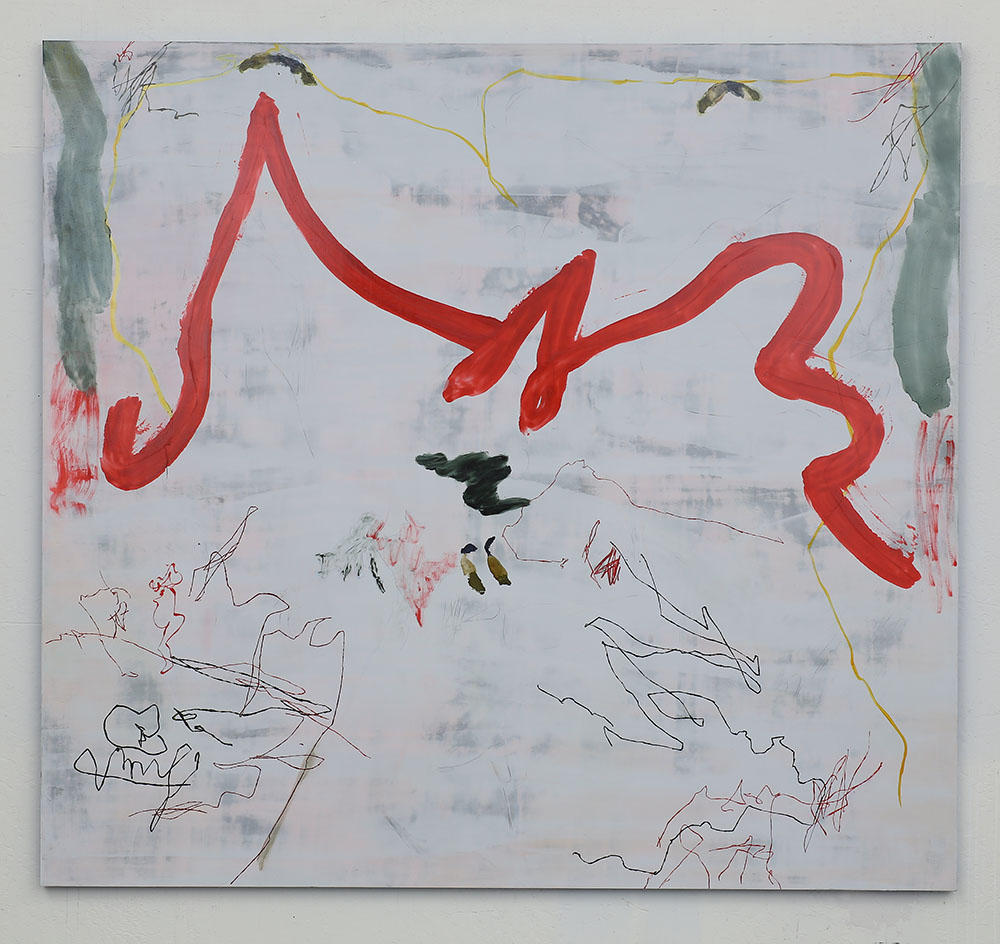
Maysha Mohamedi. “Dompteuse (Animal Trainer),” 2015. Oil on panel, 71.5 x 66 inches. Courtesy the artist.
How did this collaboration come about?
JG: We were talking about what a lot of people are talking about in San Francisco: the general lack of opportunities to have an exhibition. I have curated Maysha and you in shows. I would be happy and proud to show with anyone whose work I like. It kind of happened through a brief conversation: Would you want to do a show together, yeah, would you? Over coffee more than anything else.
And she did a painting in one of your paintings, so there was some ground established.
JG: That’s true
MM: We know we can work well together, that’s for sure.
JG: More than anything I trust her ability to work and surprise herself and have confidence. I like that. And I remember having Maysha come to my studio and pulling a James: “That’s terrible!”
MM: No I didn’t!
JG: It was the background of one my paintings and I removed it too. I had done this expressionistic background and you were like, “oh I don’t know…”
MM: It was solicited, I could tell you were insecure about that.
JG: It was solicited, but you ask people you trust. It’s more about understanding the way someone works and finding that commonality. But the most fun was thinking about how we would work collaboratively on these ceramic tiles we did.
Tell me about that.
JG: That was amazing because we sat down at a table and worked side by side. I’ve worked in the same room as artists, but where you’re doing something at the same time—it was the closest thing to taking an undergrad art class again.
MM: It kind of reminded of in school when people cheat off each other’s math tests because we were sitting this close. I could tell he was looking at what I was doing out of the corner of his eye and I would feel some movement over there. Then I would kind of see what he was doing. Then he would accuse me of copying and I would accuse him. (laughs) It was all very good natured.
JG: I remember thinking that was an interesting place. This is why we get along.
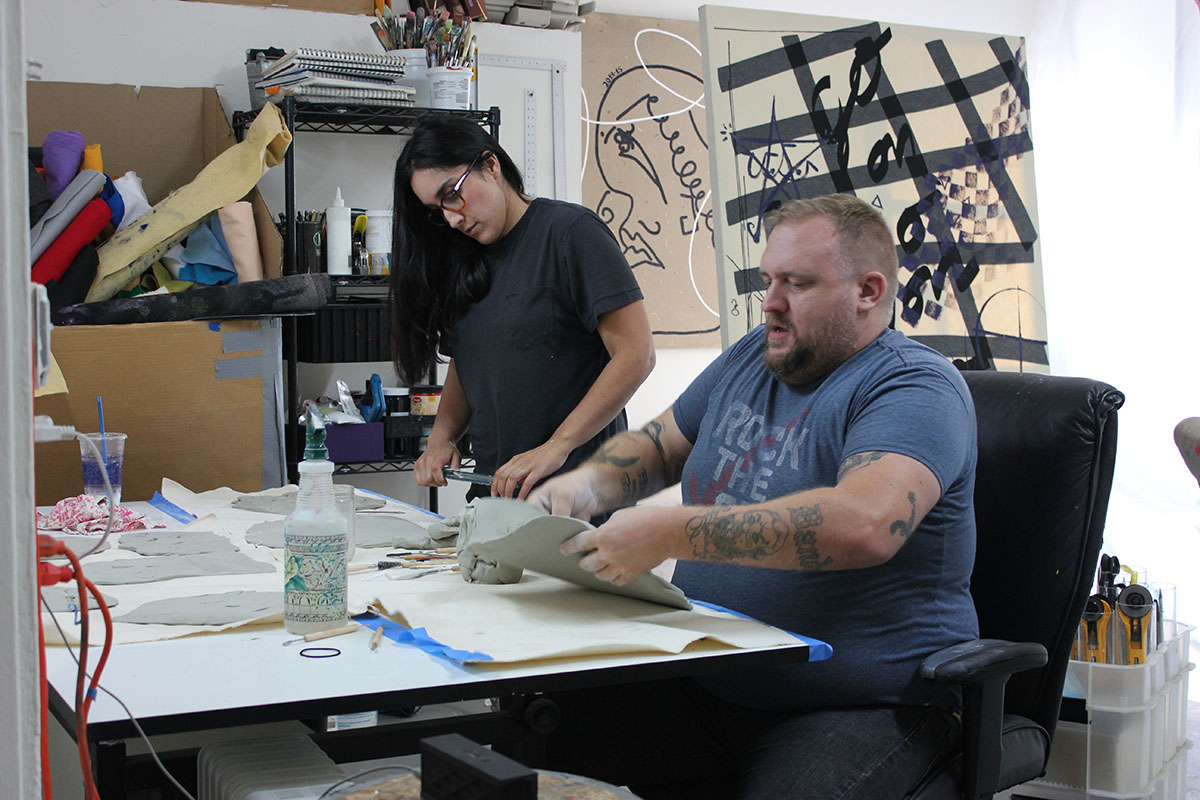
James Gobel & Maysha Mohamedi in the studio. 2015.
It’s funny because you guys are collaborating, but rather than acknowledge that you’re fully collaborating you’re ‘cheating’ off each other. Then you tease each other that you’re cheating, so you’re still not fully collaborating.
MM: Some of them we did exchange and each make movements on the tiles. But then he made I tile I really liked and I made one. . .
JG: We both got envious of a tile we made on our own.
Can you talk about why you decided to do the pop-up on your own rather than propose it to a gallery?
JG: I think it’s exciting when artists make a break. There are no rules and the stakes are different. It’s all on our ability to make a good show—to deal with the situation independent of the gallery’s commercial needs. Also, doing something at a weird place at a weird time—it breaks the monotony. Those are the shows that I often get really inspired by.
MM: Yeah, I like the idea of not giving 50% of what I made to somebody. I wouldn’t say I have the expectation to sell, but the idea that I wouldn’t have to give somebody half is really empowering.
This feels significant to a larger trend. It seems that artists are feeling empowered or at least the desire to be more independent. Can you talk about what you think is the impetus for this?
JG: For me it’s about keeping the spirit of why we make art as artists. In situations like this it’s at its most true. It’s really about making and putting it in a space where it can be viewed without any art world agenda. This is more a show for people who like artists making art. The only people who are going to attend are people who pay attention to our press release, people in the know. This isn’t a big show at MoMA where the destination already exists. It’s a moment.
It seems like this is a moment for a lot of artists who want to capture this energy. Are people getting fed up with the commercial system? Or is it the lack of opportunity because we’re in the Bay Area?
MM: I’m impatient. It doesn’t feel good to wait around and be picked by somebody. I’m making a lot of artwork. There’s this disconnect between the spirit I bring to my studio practice and waiting to be asked to dance. Doing this project together is a way to empower ourselves to do what we want to do. I feel like I’ve brought a different spirit to the work that I’ve made because the space is 100% under our terms.
JG: When I think back to my very first opportunities when I was at UNLV when Jeffrey Vallance was a visiting artist, his project was to take all the students he was working with and put them in a show at a venue he would pick. And the venues he would pick were at the Ocean Spray Museum or the Liberace Museum. That spirit was so fun and so adventurous. His take was really different because that was his practice. People ended up paying attention to what he was doing. I think the most interesting things in the world, whether it’s music or whatever, can come out of the least suspected places.
Can you talk about the title Gift A Feast and how it relates to your work?
MM: We are borrowing the space from a woman named Gypsy that we met on my mom’s online group. She runs a business called Gift A Feast that does delivery of gourmet San Francisco goods. She has a showroom and a production area. The showroom is basically empty and she offered that to James and me. She’s been like a fairy godmother to us, giving us the space for two weeks. James and I visited the space and we liked the idea of using the identity of that business as our inspiration. We called the ‘gallery’ Gift A Feast and are calling our show Gift A Feast.
Do you feel like that title has impacted the work you are making?
JG: I can only guess that if the business were something different, we might have had a different reaction to “Gift A Feast.” But it reflects her generosity…
It is also a ‘feast for the eyes.’
MM: Yes! It’s weirdly in line with the kind of objects we want to make. You want delicious San Francisco treats sent to your home? Here’s another kind of feast (for the eyes!) My painting for the show literally looks like a box with a ribbon around it: it looks like a gift. But it’s abstract. My subconscious couldn’t help it.
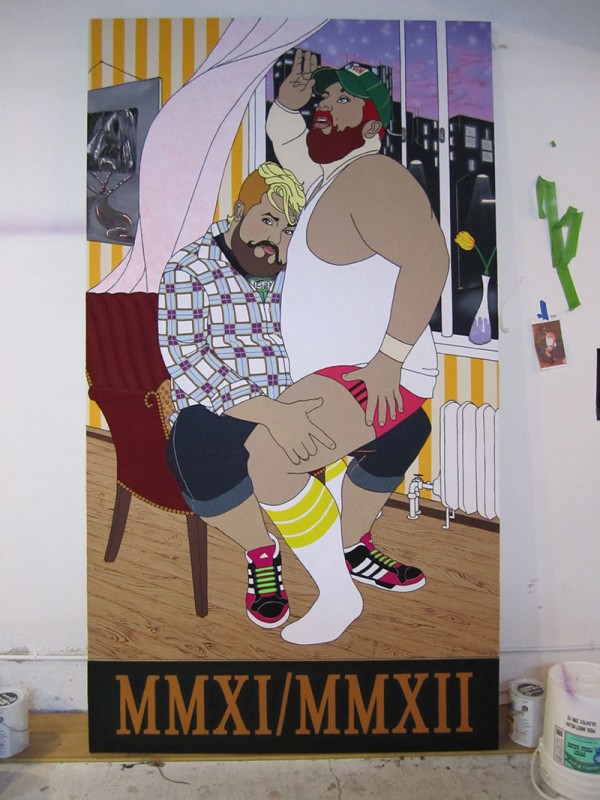
James Gobel. “No Room For Doubt (Featuring Maysha Mohamedi),” 2011. Felt, yarn, acrylic and rhinestones on canvas, 108 x 60 inches.
James, can you talk about your new role as Chair of the Graduate Studies at CCA and how it has affected your artist practice versus your role as Chair of the Painting Department or as a tenured professor.
JG: The responsibility I now take? My honest answer is my priority is what keeps me happy at work and what allows me the most time in my studio. I’ve found my work/life balance is a lot better doing administrative work because I get to weigh in on the more visionary aspect of ‘what does the Graduate Department look like today?’ How is it going to change and be better? Getting to bring in interesting visual artists. That’s what’s exciting to me. Having my friends come up, meet new artists whose work I admire. Right now it’s a really satisfying way to have a full-time job.
I read recently about your partner, Sam Bass, who is principal of Miraloma Elementary School. He was recently in the news for creating the first gender-neutral bathrooms at an elementary school. As you both are in leadership positions at educational institutions, do you feel you have an influence on each other?
JG: I think we both have the ability to grab the attention of a room. What I really learn and share with him is how to be a more efficient administrator. We both understand what a day as an educator is like.
Maysha, you’re a mother of a two year old. Do you feel like that has changed your relationship to your career as an artist or your studio practice as a painter.
MM: After going through the experience of childbirth, and now having a toddler, my body is constantly being pushed to the limit. So, because of that, physical challenges in the studio do not phase me. It’s nothing compared to the everyday physical duress of having a toddler. Things that might have seemed insurmountable just don’t any more. On the other hand, I’m weaker than ever so when I go into the studio, I feel like I have to be very careful. But I’m doing these really aggressive tasks like drilling and sawing and hammering, but I think I’m just propelled by my spirit. I do these really physically demanding things. It’s like those stories you hear about mothers being able to lift a heavy car off of their child, that’s the energy I bring when I’m in the studio.
In terms of the art world, I was really afraid of telling people that I was pregnant because I feared that people would immediately think my art career was over. And I did have comment like, “Oh, do you still have your studio?” The implication being, because you’re pregnant, a) you wouldn’t be able to make art, and b) you won’t have time to make art once you have a child. I definitely felt some of that. My fear was validated. But the nice surprise in having a child is there are many other artists that have children so there’s a camaraderie that I have with them. Even artists who are way more advanced than me, that’s a commonality we share and something we can talk about.
The most important thing that’s changed my relationship to the art world is I bring more meaning to the process. My entire life has so much meaning because I am responsible for someone living and thriving—so it’s nice to have that richness in my everyday life that I can bring to my studio practice. I think what I’m making has that spirit.
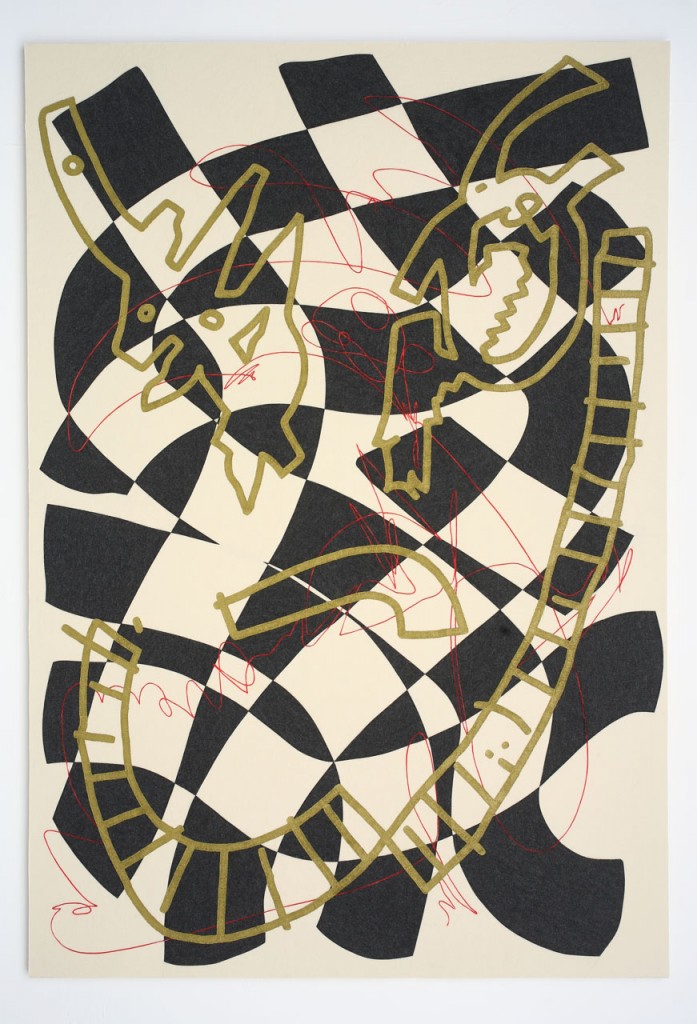
James Gobel. “Golden Shower Smile,” 2015. Felt, yarn, acrylic on canvas, 96×65.5 in.
What do you envision as the future of art, painting, San Francisco, etc.
JG: One of the things that makes the show fun for us to do is to know that in some way it might continue the industrious spirit that San Francisco needs in a time of a largely changing economy. Why all these people want to be in a city with as much character as San Francisco has, is because of people that make the creative scene happen. And it isn’t just SFMoMA, or the large institutions.
Not at all. That’s just a small sample of what you get here.
JG: Right, it’s the skater kids doing shows. Obviously I’m in a different stage in my life than the younger artist scene, but any way to crack it open—a reason to have an artistic experience. This is for the artists more than anything else. It’s a reward for paying attention.
In some ways, James, you being where you are with your career validates the experience of renting out a space and doing a pop-up show. It sets a precedent that no one should feel they can’t do this. Artists of all levels should feel comfortable saying ‘Fuck it, I don’t need a gallery to do a pop-up show.’ I don’t know. I feel like there’s a stigma in not having a gallery attached to a project, but in this case it shows the potential for something new.
MM: I feel like that stigma is going away.
I agree. I think that’s what I was trying to get a sense of—what is that about?
JG: If the art world is going to stay in SF, then it needs to adapt. It won’t be LA or NY: we don’t have the collector base. We don’t have the desire for the city to have as many gallery spaces. But what we do have is these kinds of experiences. Doing it for our own community makes it an ‘open to the public bash’ in a way. It feels like we’re doing it for each other.
